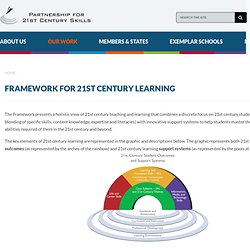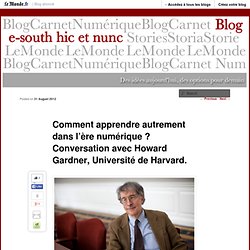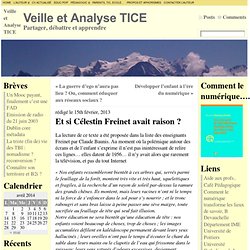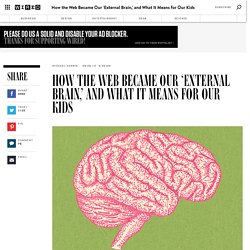

Comment Internet agit sur notre cerveau. Construire notre futur, Lors de la conférence comment construire un... SR-1382A_UPRI_future_work_skills_sm.pdf. _FutureWorkSkillsSummary_01.gif (Image GIF, 1633x1033 pixels) - Redimensionnée (76%) 2005_siemens_ALearningTheoryForTheDigitalAge.pdf. Education Futures. Framework for 21st Century Learning. The Framework presents a holistic view of 21st century teaching and learning that combines a discrete focus on 21st century student outcomes (a blending of specific skills, content knowledge, expertise and literacies) with innovative support systems to help students master the multi-dimensional abilities required of them in the 21st century and beyond.

The key elements of 21st century learning are represented in the graphic and descriptions below. The graphic represents both 21st century student outcomes (as represented by the arches of the rainbow) and 21st century learning support systems (as represented by the pools at the bottom). While the graphic represents each element distinctly for descriptive purposes, P21 views all the components as fully interconnected in the process of 21st century teaching and learning. 21st Century Student Outcomes and Support Systems 21st Century Student Outcomes 1.
Comment apprendre autrement dans l’ère numérique ? Conversation avec Howard Gardner, Université de Harvard. Conversation avec Howard Gardner, le père de la théorie des intelligences multiples, écrivain, professeur à l'université Harvard aux États-Unis.

Il est connu pour sa théorie sur les intelligences multiples. Et si Célestin Freinet avait raison. La lecture de ce texte a été proposée dans la liste des enseignants Freinet par Claude Baunis.

Au moment où la polémique autour des écrans et de l’enfant s’exprime il n’est pas inintéressant de relire ces lignes… elles datent de 1956… il n’y avait alors que rarement la télévision, et pas du tout Internet. Learnersrights/bill_of_rights.md at master · audreywatters/learnersrights. Quelques défis pour la prochaine décennie. A l’occasion de ses 10 ans, l’excellent magazine américain The Chronicle of Higher Education a posé la question à des universitaires et experts de savoir quels seront les défis des 10 années à venir.

Observons les plus significatifs… The Online Destination for Generation Y. Future education. Edtechfuture. How the Web Became Our ‘External Brain,’ and What It Means for Our Kids. Recently, my two-year-old nephew Benjamin came across a copy of Vanity Fair abandoned on the floor.

His eyes scanned the glossy cover, which shone less fiercely than the iPad he is used to but had a faint luster of its own. 5 Formes d’intelligence pour affronter l’avenir. 5 Formes d’intelligence pour affronter l’avenir. Don Tapscott "Growing up Digital" 4 Ways The Internet Is Making Kids Smarter. 21st Century Literacies: Tools for Reading the World. In Intelligence Reframed Howard Gardner contends that "literacies, skills, and disciplines ought to be pursued as tools that allow us to enhance our understanding of important questions, topics, and themes.

" Today's readers become literate by learning to read the words and symbols in today's world and its antecedents. They analyze, compare, evaluate and interpret multiple representations from a variety of disciplines and subjects, including texts, photographs, artwork, and data. They learn to choose and modify their own communication based on the rhetorical situation. Point of view is created by the reader, the audience and the medium.
Basic Language Literacy Visual Literacy. GetAbstract - compressed knowledge - grown-up-digital-tapscott-e.pdf. Generation Y. Terminology[edit] Authors William Strauss and Neil Howe wrote about the Millennials in Generations: The History of America's Future, 1584 to 2069,[2] and they released an entire book devoted to them, titled Millennials Rising: The Next Great Generation.[3] Strauss and Howe are "widely credited with naming the Millennials" according to journalist Bruce Horovitz.[1] In 1987, they coined the term "around the time 1982-born children were entering preschool and the media were first identifying their prospective link to the millennial year 2000".[4] Strauss and Howe use 1982 as the Millennials' starting birth year and 2004 as the last birth year.[5] Newsweek used the term Generation 9/11 to refer to young people who were between the ages of 10 and 20 years on 11 September 2001.

The first reference to "Generation 9/11" was made in the cover story of the November 12, 2001 issue of Newsweek.[17] Traits[edit] William A. New Literacy in the Web 2.0 World. Education 3.0 and the Pedagogy (Andragogy, Heutagogy) of Mobile Learning. The evolution of the web from Web 1.0 to Web 2.0 and now to Web 3.0 can be used a metaphor of how education should also be evolving, as a movement based on the evolution from Education 1.0 to Education 3.0.

I discussed this in Schools are doing Education 1.0; talking about doing Education 2.0; when they should be planning and implementing Education 3.0. Many educators are doing Education 1.0; talking about doing Education 2.0; when they should be planning and implementing Education 3.0. This post compares the developments of the Internet-Web to those of education.
The Internet has become an integral thread of the tapestries of most societies throughout the globe. Literacy in the Digital Age. Teach ICT - Tons of Free Teaching Materials and ICT Revision. IJCIR. La Génération Y : des pilotes de course qui doivent passer leur. Que l’on se fie à une récente étude d’Accenture ou à tout ce qui peut se dire et s’écrire çà et là (liste trop longue pour être publiée ici), la génération des Millenials ou des Digital Natives va considérablement faire changer la manière dont on travaille en entreprise.

Quelque part c’est une chance inouïe tant ils ont les réflexes qu’on demande à des collaborateurs dans une entreprise agile, interconnectée. Mais toutes les études semblent également s’accorder sur un point un peu moins reluisant : leur très faible niveau de compréhension des enjeux de l’entreprise que ce soit au niveau opérationnel ou au niveau de la nécessaire gouvernance de l’information. En quelques sorte des pilotes de course qui devraient encore leur “permis de conduire en entreprise”. Vous me direz que nous n’en savions sans doute guère plus qu’eux lorsque nous avons fait nos débuts.
Digital Differentiation. Technology is a tool that can be used to help teachers facilitate learning experiences that address the diverse learning needs of all students and help them develop 21st Century Skills.

At it's most basic level, digital tools can be used to help students find, understand and use information. When combined with student-driven learning experiences fueled by Essential Questions offering flexible learning paths, it can be the ticket to success. Here is a closer look at three components of effectively using technology as a tool for digital differentiation. Note: The interactive graphics you see below have been updated. They can be found in a newer post on this blog. Talking Digital Literacy with Howard Rheingold. Yesterday I attended an event with Howard Rheingold as the keynote speaker. Rheingold is best known for his work at The Well (one of the first virtual communities) and his 2002 book Smartmobs, a forecast of the always-on era. Rheingold talked about Digital Literacy at the University of Utrecht, who organized this event together with the main Dutch platform for media literacy called MediaWijzer.
Of course his theories from his latest book, Net Smart, feeded most of the talk and discussion. 20 ways of thinking about digital literacy in higher education. Josie Fraser, social and educational technologist, Leicester City Council First define what you mean by digital literacy: The definition I most frequently use is this one: digital literacy = digital tool knowledge + critical thinking + social engagement.
Enfants et écrans : psychologie et cognition. L’Académie des sciences vient de publier un rapport (.pdf) sur la relation des enfants aux écrans (disponible également sous la forme de livre aux éditions Le Pommier), un rapport qui tord le cou à nombre d’idées reçues sur le sujet et fait le point sur les connaissances scientifiques, éducatives et neurobiologiques. The Generation Y Learning Journey - Ashridge. 10 compétences-clefs pour l'avenir. Generation Y and learning - Ashridge.
Ashridge research Research was undertaken in late 2008 to identify the development needs and learning preferences of Generation Y compared to those of previous generations, and to provide recommendations to assist with future learning, teaching and workplace practice. GenerationY. Information Age. A visualization of the various routes through a portion of the Internet. The Information Age (also known as the Computer Age, Digital Age, or New Media Age) is a period in human history characterized by the shift from traditional industry that the industrial revolution brought through industrialization, to an economy based on information computerization. The onset of the Information Age is associated with the Digital Revolution, just as the Industrial Revolution marked the onset of the Industrial Age. During the information age, the phenomenon is that the digital industry creates a knowledge-based society surrounded by a high-tech global economy that spans over its influence on how the manufacturing throughput and the service sector operate in an efficient and convenient way.
The Information Generation « Faster Than Light. Une jeune journaliste raconte comment les 20/30 ans voient le travail. Adora Svitak: What adults can learn from kids. Nine Shift. Nine Shift: Work, Life and Education in the 21st Century (2004), is a non-fiction book about futurism. It is co-authored by William A. Draves and Julie Coates.[1][2] Overview[edit] La révolution cognitive. Bloom’s Taxonomy: The 21st Century Version. Planete Y. Millennials Trust User-Generated Content 50% More Than Other Media. It seems as if millennials have avoided traditional media ever since they learned how to read. The results of new research by marketing startup Crowdtap and the global research company Ipsos shed new light on how the connected generation gets its news. When it comes to trust, it turns out, millennials almost always choose their peers over professionals.
User-generated content (UGC) is media created by your peers. It includes status updates, blog posts and restaurant reviews — any content from non-professionals without any real motivation besides adding an opinion to the sea of already existing opinions. In a more logical world, it isn't the type of content we'd trust over a professional's review. Who Are the Millennials? This post was written by Jenny Urbano, our Social Media Manager. Here at Demandforce, we love seeing and celebrating your ideas! And more than that, we love to hear from YOU.